Life During Wartime
Any visitor to Vietnam, especially an American visitor to Vietnam, must eventually face this country’s recent history of prolonged and bloody warfare. I wish I could trot out the facts of the Vietnam War, names, dates, places, battles and casualties. But I can't. Most of what I know about the war comes from the movies, and cinema’s the most unreliable source of all. Suffice to say there was a bloody, unjust conflict that lasted much longer than it should have and cost tens of thousands of American lives and many more Vietnamese. It was once the worst conflict of my lifetime, a fiasco of epic proportions that divided the U.S. and remains a smear upon American foreign policy. In the end, as I understand it (from movies, you see), American lost.
My experience in Cambodia led me to believe that I would see few reminders of the Vietnam War in Ho Chi Minh City, formerly Saigon. I doubt the patriotic billboards bearing Vietnamese text and the face of Ho Chi Minh recall the days of American occupation. There are, as far as I can tell, no memorial statues at crowded city roundabouts or streets bearing the names of war heroes. The war seems something to be forgotten, a remnant of the past best swept aside in favor of a bright capitalist future.
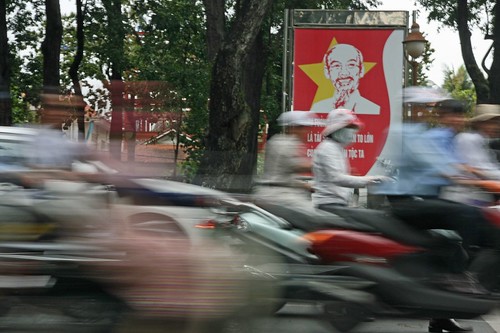
Speeding Past Ho Chi Minh
There are, nevertheless, a few places in HCMC where visitors can learn about the Vietnam War. Whether the War Remnants Museum and the tour of the Cu Chi Tunnels impart practical, impartial lessons about the Vietnam War in particular and war in general is another issue altogether.
The first thing to know about the War Remnants Museum – other than that it is the most popular site in HCMC for Western tourists – is that its original name was “The Museum of American War Crimes.” In a bid for tourist dollars, the name was changed. Yet the content still screams “Imperialist Pigs!”
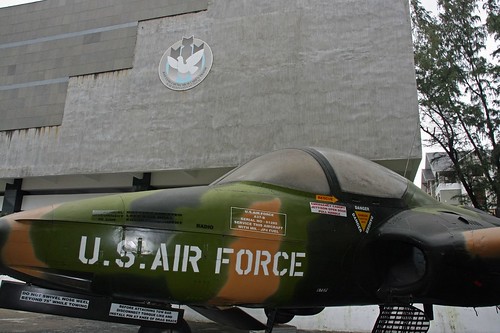
Exterior of the War Remnants Museum
I’m not saying Americans aren’t capable of committing heinous acts – the last few years alone have shown that when it comes to torture and warfare, America is at the top of its game. It’s just that the War Remnants Museum lays it on thick. I’m not squeamish, but there are better ways to make a point than by displaying photographs of American soldiers with mutilated corpses. (In one display, Senator John Kerry is said to have confessed to massacring civilians. How did I miss that confession during the 2004 campaign?)
The museum emphasizes image over interpretation. The dozens of photos of battlefield casualties, tortured civilians, dead babies and the elderly, and victims of chemical attacks and Agent Orange are gruesome and disturbing. I was given little context in which to understand what happened or why. I wasn't even given a one-sided account of why Americans are Imperialist Pigs who kill babies for sport.
The photos at the War Remnants Museum are powerful records of the conflict. There is truth in photography. With proper labeling and a solid record of events, they might better explain the feelings the Vietnamese people hold toward Americans in regard to the war. Instead, the whole museums comes across as a huge indictment of the men and women who served in the military. I left the museum with no more understanding of the conflict in Vietnam than I had when I entered.
I remind you as I remind myself – it was originally called “The Museum of American War Crimes.”
A strange aspect of the War Remnants Museum is that the most powerful exhibit has nothing to do with the “War Crimes.” The most interesting exhibit, and the most crowded, was devoted to journalists killed during the conflict. Chances are slim that the Vietnamese government believes it’s a war crime to kill journalists. The exhibit most likely exists due to the availability of solid material.
The exhibit is fascinating. Photos by the dead photographers line the walls. There are headshots of each journalist, with names and the dates of their deaths. It is a comprehensive, informative and moving testament to the men and women who lost their lives practicing their craft.
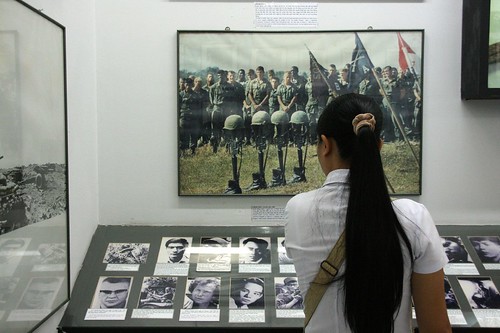
Display on Fallen Journalists
The second tourist attraction related to the war is the Cu Chi Tunnels, a vast network of underground passages controlled by the Vietcong during the 1960’s. The VC used the network of more than 250 kilometers of tunnels to launch attacks on American and South Vietnamese forces as well as elude capture. There is a fascinating history to the tunnels, and the fact that they still exists is a tangible reminder of the lengths to which people will go during times of war. Unfortunately, the tunnels have been turned into a bit of a circus in an attempt (successful attempt) to lure the tourist dollar.
Instead of presenting the complex as an open area and inviting visitors to explore at their leisure, the Cu Chi Tunnels are presented as a group activity. A short film is followed by a short introductory lecture. Then a guide leads a group – in my case, a group of about 50 – through the woods for a tour of sniper holes, booby traps, smoke vents, hidden entrances/exits, bomb craters and recreations of VC camps. Devices used to impale and maim American soldiers are given center stage, complete with a mural depicting the homemade devices in action.

Tunnel Entrance
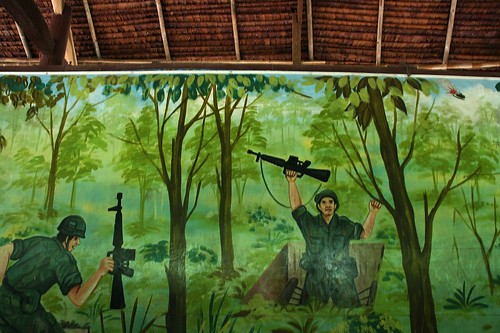
Mural Detail
A “break” is provided at the halfway point. The guide said it was to gather our strength for when we enter the tunnels themselves. But that doesn’t explain why there’s a firing range next to a souvenir shop, a firing range offering tourists the chance to fire AK-47s, M-16s and other automatic weapons at just over US$1 a bullet. I was parched and bought a Coke (for which the women behind the counter tried to shortchange me). A few gulps later and my brain was knocked askew by a horrendously loud barrage of gunfire. At a buck a bullet, tourists were only buying two, three, five rounds at a time. Still, who puts a firing range, a firing range offering automatic weapons, next to a snack shop?
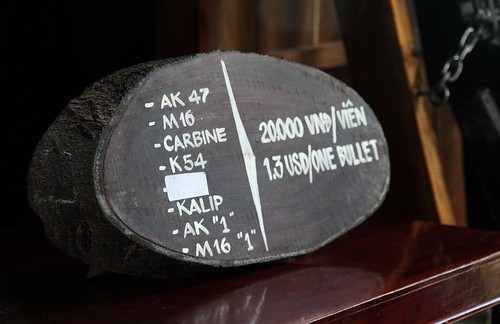
Weapons Menu
The grand finale of the tour was a group crawl through a 150-meter long tunnel. The Cu Chi tunnels are no more than a meter high and not much wider than an average human. A professional football player would not fit. A few lights have been installed for the tourists, but with a large group they are obscured. Most of my time was spent in pitch-black conditions talking a terrified woman in front of me through the experience. Behind me a group of Chinese teenagers squealed in mock fright, filling the tunnel with an irritating din.
The Cu Chi Tunnels were an important feature of the Vietnam War. I would have like to be able to crawl through them in silence, to pause and consider the reasons for their existence, to imagine myself a VC who is forced into an underground existence. The misery the VC must have endured in these conditions is beyond my comprehension. Any attempt to understand this was lost in the circus that the tunnels have become.
My experience in Cambodia led me to believe that I would see few reminders of the Vietnam War in Ho Chi Minh City, formerly Saigon. I doubt the patriotic billboards bearing Vietnamese text and the face of Ho Chi Minh recall the days of American occupation. There are, as far as I can tell, no memorial statues at crowded city roundabouts or streets bearing the names of war heroes. The war seems something to be forgotten, a remnant of the past best swept aside in favor of a bright capitalist future.

There are, nevertheless, a few places in HCMC where visitors can learn about the Vietnam War. Whether the War Remnants Museum and the tour of the Cu Chi Tunnels impart practical, impartial lessons about the Vietnam War in particular and war in general is another issue altogether.
The first thing to know about the War Remnants Museum – other than that it is the most popular site in HCMC for Western tourists – is that its original name was “The Museum of American War Crimes.” In a bid for tourist dollars, the name was changed. Yet the content still screams “Imperialist Pigs!”

I’m not saying Americans aren’t capable of committing heinous acts – the last few years alone have shown that when it comes to torture and warfare, America is at the top of its game. It’s just that the War Remnants Museum lays it on thick. I’m not squeamish, but there are better ways to make a point than by displaying photographs of American soldiers with mutilated corpses. (In one display, Senator John Kerry is said to have confessed to massacring civilians. How did I miss that confession during the 2004 campaign?)
The museum emphasizes image over interpretation. The dozens of photos of battlefield casualties, tortured civilians, dead babies and the elderly, and victims of chemical attacks and Agent Orange are gruesome and disturbing. I was given little context in which to understand what happened or why. I wasn't even given a one-sided account of why Americans are Imperialist Pigs who kill babies for sport.
The photos at the War Remnants Museum are powerful records of the conflict. There is truth in photography. With proper labeling and a solid record of events, they might better explain the feelings the Vietnamese people hold toward Americans in regard to the war. Instead, the whole museums comes across as a huge indictment of the men and women who served in the military. I left the museum with no more understanding of the conflict in Vietnam than I had when I entered.
I remind you as I remind myself – it was originally called “The Museum of American War Crimes.”
A strange aspect of the War Remnants Museum is that the most powerful exhibit has nothing to do with the “War Crimes.” The most interesting exhibit, and the most crowded, was devoted to journalists killed during the conflict. Chances are slim that the Vietnamese government believes it’s a war crime to kill journalists. The exhibit most likely exists due to the availability of solid material.
The exhibit is fascinating. Photos by the dead photographers line the walls. There are headshots of each journalist, with names and the dates of their deaths. It is a comprehensive, informative and moving testament to the men and women who lost their lives practicing their craft.

The second tourist attraction related to the war is the Cu Chi Tunnels, a vast network of underground passages controlled by the Vietcong during the 1960’s. The VC used the network of more than 250 kilometers of tunnels to launch attacks on American and South Vietnamese forces as well as elude capture. There is a fascinating history to the tunnels, and the fact that they still exists is a tangible reminder of the lengths to which people will go during times of war. Unfortunately, the tunnels have been turned into a bit of a circus in an attempt (successful attempt) to lure the tourist dollar.
Instead of presenting the complex as an open area and inviting visitors to explore at their leisure, the Cu Chi Tunnels are presented as a group activity. A short film is followed by a short introductory lecture. Then a guide leads a group – in my case, a group of about 50 – through the woods for a tour of sniper holes, booby traps, smoke vents, hidden entrances/exits, bomb craters and recreations of VC camps. Devices used to impale and maim American soldiers are given center stage, complete with a mural depicting the homemade devices in action.


A “break” is provided at the halfway point. The guide said it was to gather our strength for when we enter the tunnels themselves. But that doesn’t explain why there’s a firing range next to a souvenir shop, a firing range offering tourists the chance to fire AK-47s, M-16s and other automatic weapons at just over US$1 a bullet. I was parched and bought a Coke (for which the women behind the counter tried to shortchange me). A few gulps later and my brain was knocked askew by a horrendously loud barrage of gunfire. At a buck a bullet, tourists were only buying two, three, five rounds at a time. Still, who puts a firing range, a firing range offering automatic weapons, next to a snack shop?

The grand finale of the tour was a group crawl through a 150-meter long tunnel. The Cu Chi tunnels are no more than a meter high and not much wider than an average human. A professional football player would not fit. A few lights have been installed for the tourists, but with a large group they are obscured. Most of my time was spent in pitch-black conditions talking a terrified woman in front of me through the experience. Behind me a group of Chinese teenagers squealed in mock fright, filling the tunnel with an irritating din.
The Cu Chi Tunnels were an important feature of the Vietnam War. I would have like to be able to crawl through them in silence, to pause and consider the reasons for their existence, to imagine myself a VC who is forced into an underground existence. The misery the VC must have endured in these conditions is beyond my comprehension. Any attempt to understand this was lost in the circus that the tunnels have become.
Labels: Vietnam

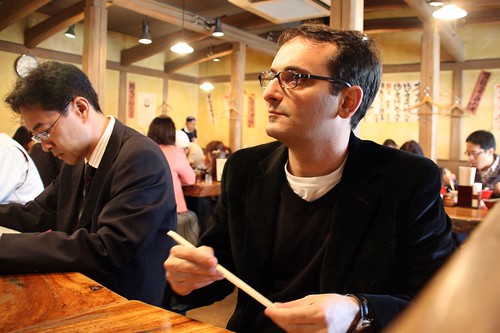

0 Comments:
Post a Comment
<< Home